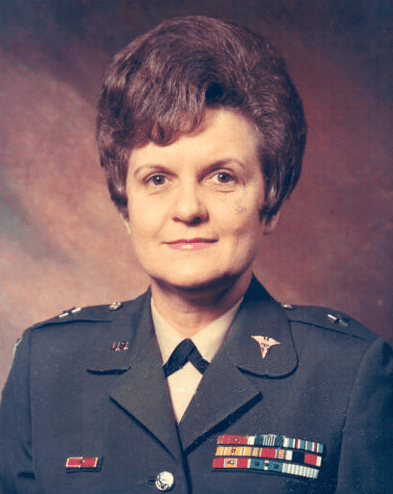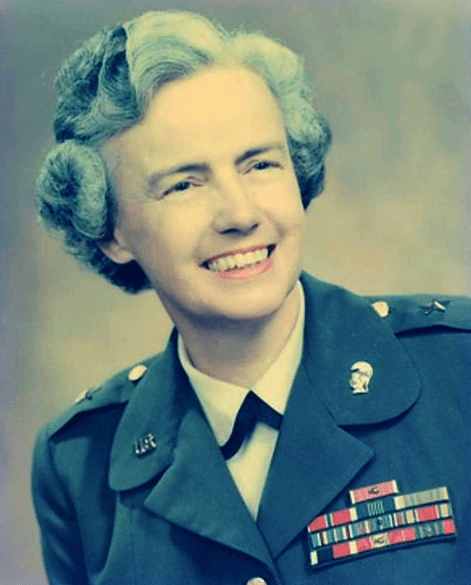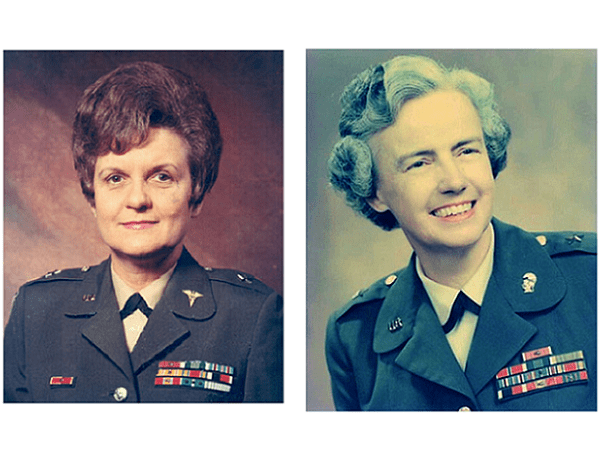A historic first was achieved on 15 May 1970 when President Richard M. Nixon nominated two female colonels to become the first women generals in the history of the U.S. military: Col. Anna Mae Hays and Col. Elizabeth Paschel Hoisington.

Since nomination by the president routinely leads to actual promotion (requiring only the formality of Senate approval), it surprised no one when the two women received their one-star rank as brigadier generals on 11 June 1970. They were the first women generals in the (at the time) 196-year history of the U.S. Army.

Both women had entered military service during World War II in 1942 and served with distinction throughout their military careers. At the time of their promotions Col. Hays was chief of the Army Nurse Corps and Col. Hoisington director of the Women’s Army Corps. The parallels of their careers continued one year after their promotions, when both women generals retired in August 1971.
The following five newspaper articles are about these two women generals’ historic achievement. The first three articles are about their nomination on May 15, and the last two articles report their official promotion on June 11.
Here is a transcription of this article:
No Longer ‘This Man’s Army’
Two Women to Get General’s Star
WASHINGTON (AP) – President Nixon has nominated the first two women generals in the history of the U.S. armed forces, it was announced Friday.
The Pentagon said Col. Elizabeth P. Hoisington, director of the Women’s Army Corps, and Col. Anna Mae Hays, chief of the Army Nurse Corps, have been selected by the President for promotion to the temporary rank of brigadier general.
Congress authorized general officer rank for women three years ago, but this is the first time that any woman in uniform has been picked to wear a star.
Col. Hoisington, a native of Newton, Kan., enlisted in the World War II Women’s Army Auxiliary Corps in 1942 and was commissioned a year later. She became director of the WAC in August 1966.
Col. Hays, born in Buffalo, N.Y., also entered the Army in World War II, first serving in 1942 as an operating-room nurse. She became chief of the Army Nurse Corps in September 1967.
Col. Hoisington is a graduate of the College of Notre Dame of Maryland. Col. Hays received her nurses’ training in Allentown, Pa., her nursing education degree from Columbia University, and a master’s degree from Catholic University.
The two were included in a list of 82 Army colonels selected for promotion to one-star rank.
Col. Hays learned about her nomination after she had left her office for the day.
She seemed skeptical, saying, “I’ll have to call somebody and find out.”
She said she had left her office during the afternoon “because I had to get my uniform fixed.”
About the only other thing that Col. Hays could say, in her surprise, was, “My goodness.”
Col. Hoisington’s Pentagon office was the scene of great jubilation.
The WAC chief told a reporter over the phone that about 25 of her male officer friends had come in to congratulate her, and “they all are kissing me.”
Col. Hoisington said she had learned of her nomination only a few minutes before the public announcement and that she had had no advance indication of it.
Neither of the women colonels said they regarded their promotion as a stroke for womankind.
“We’ve always gotten our due from the Army,” said Col. Hoisington, who described herself as “an Army brat.” Her father was a colonel and her three brothers all went to West Point.
“The Army is my first love,” she said.
Col. Hoisington said more and more women colonels are being named and “they are paving the way for others to follow.”
Col. Hays, when asked about the drive for women’s liberation, said, “let’s not talk about that.”
She said she regarded her promotion as “recognition for service.”
Col. Hoisington is 51, Col. Hays is 50.
In her career, Col. Hoisington served in Europe during World War II, later went to Japan and since then has had a variety of staff positions.
The WAC chief wears, among other decorations, the French Croix de Guerre with Silver Star, the Legion of Merit and the Bronze Star. She is single.
Her official address is Santa Barbara, Calif.
Col. Hays, a widow, served in India during World War II, in Korea and Japan during the Korean War, and later rose to head nursing positions in a series of Army hospitals, including Walter Reed.
Her decorations include the Legion of Merit.
Here is a transcription of this article:
‘Women Standing Taller’
WASHINGTON (UPI) – The first two women to be nominated for the rank of general agreed Saturday that it’s mainly a point of honor.
“I don’t know; I’ve never been a general before,” said Col. Anna Mae Hays, Chief of Army Nurses, when asked whether her new rank would make [a] difference in her operations.
“The greatest thing is the honor they are paying us,” said Col. Elizabeth M. Hoisington, director of the Women’s Army Corps (WAC). “All women are standing taller today.”
President Nixon nominated the two lady colonels along with 80 male colonels for promotion to the rank of brigadier general late Friday. Although the action is routine, the nominations require the approval of the Senate.
Congress authorized the designation of women generals in 1967, but it has taken three years for the first of them to appear on the nominating list.
Here is a transcription of this article:
Talk about women getting their rights. Elizabeth P. Hoisington and Anna Mae Hays are certainly going to be able to lord it over a good many fellows.
The two ladies are the first of their sex to be nominated to be generals. Actually, the promotions are long overdue since both women have responsibilities well deserving of the rank.
But we cannot help but wonder what Army regulations say about a general wearing a miniskirt.
Here is a transcription of this article:
Lady Generals Break 196-Year Army Tradition
WASHINGTON (AP) – Generals kissed generals at the Pentagon Thursday [June 11] as the Army handed stars to women for the first time in its 196-year history. Gen. William C. Westmoreland, Army chief of staff, called it an historic occasion. A WAC private, turning to her companion, said: “We did it. Did you ever see so many liberated women in your life?”
“Theirs was a long, slow path before receiving just recognition,” Westmoreland said to the applause of the Army’s top brass as he formally elevated Cols. Elizabeth P. Hoisington and Anna Mae Hays to the rank of brigadier general.
Secretary of the Army Stanley Resor pronounced them “first ladies of the Army.”
After helping pin a silver star on each shoulder, Westmoreland declared what he called “a new protocol for congratulating lady generals” and kissed Gen. Hays, chief of the Army Nurse Corps, on the cheek.
Minutes later, the four-star general repeated the ceremony with Gen. Hoisington, director of the 12,000-member Women’s Army Corps, and kissed her “in accordance with the well-established Army protocol…”
Their formal promotion fell one day short of the 22nd anniversary of the establishment of the Women’s Army Corps (WACs) as a permanent part of the Army. Although organized in 1942, it wasn’t until six years later that the WACs were given permanent status.
Gen. Hoisington, a native of Newton, Kan., enlisted as a private at the start of World War II. She was the first WAC to enter Paris after its liberation by the Allies in 1944 and the first to win the Bronze Star in the European theater.
She is a self-styled Army brat whose father was a colonel and whose three brothers graduated from West Point. She noted that an older brother, Perry Hoisington, is a retired Air Force major general.
“I have run lickety brindle down the road and never have been able to catch up with him,” the 51-year-old WAC chief said. She might yet, if she stays with the WACs a few years longer.
Gen. Hays, who was born in Buffalo, N.Y., and received her nurses’ training in Allentown, Pa., has headed the 5,000-member Army Nurse Corps since 1967.
A widow, she also enlisted during World War II, served in India and later in Korea during the fighting there in the 1950s.
The 50-year-old Mrs. Hays also held chief nursing positions in a series of Army hospitals, including Walter Reed, where she personally tended President Dwight D. Eisenhower. Eisenhower’s widow, Mamie, led the line of people congratulating the new lady generals.
Here is a transcription of this article:
Army Enlists Skills of First Lady Generals
By Frances Spatz Leighton
They’re amazingly alike – the two women who scarcely know each other but share the honor of being the first lady generals in American history. Both love to clean house but hate to cook. “I can do it, but I don’t,” says Anna Mae Hays, chief of the Army Nurse Corps. Elizabeth Hoisington, director of the Women’s Army Corps (WAC), is the first to admit her cooking is the joke of the Army. “If anyone wants to know anything about frozen pot pies, they consult me,” she says.
Neither has a maid. They do their own cleaning, “for exercise.” Both drive Cadillacs, using staff cars only for official occasions. Both live in Arlington, Virginia, in apartments.
But, they are headquartered in different military complexes. Gen. Hoisington works from the Pentagon in Virginia, and Gen. Hays crosses the Potomac to Washington, D.C., to the James V. Forrestal Building.
Both command thousands of military personnel. Gen. Hoisington directs 13,000 women of the WAC – 12,000 enlisted and 1,000 officers. Gen. Hays supervises 5,000 Army nurses.
Both have toured the danger zones of Vietnam and have been decorated for meritorious service. Both rose slowly in rank, taking 28 years to achieve their current honor – the rank of Brigadier General.
The Spartan habits they’ve learned are still with them even though they now could afford to slow down. Gen. Hays is up at 5:15 a.m., tries to be at the office by 7 a.m., and goes to bed by 9 p.m.
Gen. Hoisington is up at 5:45 a.m. She breakfasts at 7 a.m. at the Pentagon with an assistant who starts briefing her on events of the day. She tries to stay awake through the 10 p.m. TV news.
Both are calorie-conscious, slim, chic and determined to stay that way.
Both are extremely feminine, changing to dresses when they get home and going to beauty parlors regularly.
Both of the lady generals’ offices have been extremely hectic since their historic promotions by President Nixon on May 15. Thousands of letters and telegrams have been pouring in from friends, high-ranking military men, and women serving in the worldwide WAC and Nurse Corps.
From the 45th Surgical Hospital at Tay Ninh, Vietnam, to which servicemen injured in Cambodia are taken, a nurse wrote Gen. Hays, “This means so much to the morale of all nurses. Your promotion is a promotion for all of us.”
An enlisted woman stationed at Heidelberg, Germany, wrote Gen. Hoisington, “Hooray! Am so proud to be a member of the Women’s Army Corps and to be able to have a Lady General Leader.”
Both petticoat generals exhibit an unusual modesty, refusing to consider their promotion their own personal triumph.
Gen. Hays says, “I think of it not for myself, but that the honor has come to the men and women of our corps. And, 18% are men, you know. This represents no special merit of mine, but their dedicated, selfless and heroics efforts wherever they are stationed to help the wounded.”
Gen. Hays entered the military service May 15, 1942. This gives her an edge over Gen. Hoisington who entered the WAC six months later. Since the bill establishing the WAC was passed in May, friends kid Gen. Hoisington, asking, “What took you so long?” Gen. Hoisington has the best excuse in the world. She was in Alaska at the time because her father was in the Army and stationed there. She joined the WAC the moment she got back to the States. Now she says, “The Women’s Army Corps couldn’t have a more wonderful 28th anniversary present than what President Nixon did for us. All our women are standing taller today.”
There was no big fanfare, no great calls from the White House preceding the announcement of the nominations. Both gals were caught off guard. “I was in the office at 4:30 p.m. on May 15, when I got a call from my boss, the Deputy Chief of Staff, Lt. Gen. Walter Kerwin. He told me we had been nominated by the President – Col. Hays and I. I couldn’t speak. I’m afraid there were tears in my eyes.”
Meanwhile, Col. Hays could not be found in her office. She had rushed home to change her hose and pick up something for a trip. The phone rang and she answered. It was the press calling to get her reaction to the announcement. “So that’s how I learned of it,” she laughs, “from an AP or UPI reporter, I was too excited to ask.”
Despite similarities of their present situations, the lady generals have diverse backgrounds. The nurses’ chief came from a very musical family and plays the piano, French horn, cornet, organ and ukelele herself. Her father was associated with the Salvation Army at Allentown, Pa. “That’s what made me interested in public service,” she adds.
Gen. Hoisington’s father was with the U.S. Army and she comes from a completely military family. “I’m an Army brat,” she says. “I was raised on Army posts. But never in my wildest dreams as a child did I think of being a general. But the military was my way of life.” Her father, the late Col. Gregory Hoisington, was a graduate of West Point and taught there. Her three brothers, one of whom is deceased, were also West Pointers.
Elizabeth Hoisington was born in Newton, Kansas, in 1918. Her father, at that time, was stationed at Hoboken, N.J., briefing troops for overseas duty in World War I. The grandfather was also a military man, the late Col. Perry M. Hoisington, known as the father of the Kansas National Guard. Completing her family picture, Gen. Hoisington’s two sisters are married to Army colonels, and brother Bob is married to a former Army nurse.
Not only is Gen. Hoisington one of the first two female generals in U.S. history, but her family also produced the first sister-brother team in the history of American generals. “My family was not too surprised when I followed the family tradition and joined the service,” says the WAC general. It was prompted by a feeling of patriotism and wanting to do her part in World War II.
She had been a chemistry and math major at the College of Notre Dame in Baltimore, Md., and tried not to take advantage of her family’s position in the military. But her own military ability was quickly discovered. She was enrolled in Officer Candidate School, followed by the WAC Officer Advanced Course.
The feelings of both women are summed up by Gen. Hoisington: “The Army has always come first with me. I guess I’m married to the Army.” Then grinning she adds, “I’ve given the Army the best years of my life. But I don’t have to feel guilty about not having children. My family has made up for me. One brother has eight.”
Note: An online collection of newspapers, such as GenealogyBank’s Historical Newspaper Archives, is not only a great way to learn about the lives of your ancestors – the old newspaper articles also help you understand American history and the times your ancestors lived in, and the news they talked about and read in their local papers – as well as more recent events.
